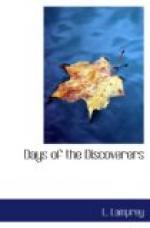“I believe,” said Cartier to Maclou as the flagship sailed gaily on over the sunlit sparkling waves, “that this must be the place from which all the whales in the world come.” The great creatures were spouting and diving all around the fleet, frolicking like unwieldy puppies. Every one was alert for what might be discovered next. None were more lively and full of pleased expectation than the two Indian youths. Captives had been taken by the white men before, but none had ever returned. Their people were undoubtedly mourning them as dead, but would presently see them not only alive but fat and happy. They had crossed the great waters in the white men’s canoe, and lived in the white men’s villages, and learned their talk. They had been christened Pierre and Kadoc, French tongues finding it hard to pronounce their former names.
Cartier called them to him and began to ask questions. He learned that the northern coast of the gulf, along which they were sailing, was that of a land called Saghwenay, in which was found Caignetdaze, called by the white men copper. This gulf led to a great river called Hochelaga. They had never heard of any one going all the way to the head of it, but the old men might remember. What the name of the country to the south of the gulf was, Cartier could not make out. It sounded something like Kanacdajikaouah. “Kaou-ah” meant great, or large, and Cartier finally set down the rest of the word as Canada, as nearly as the French alphabet could spell out the gutturals.
The youths in fact belonged to a tribe in the great confederacy of the Kanonghsionni, the People of the Long House—or rather the lengthened house, Kanonsa being the word for house, and “ionni” meaning lengthened or extended.[1] Five tribes, many generations ago, had united under the leadership of the great Ayonhwatha—“he who made the wampum belt."[2] They had adopted weaker tribes when they conquered them, exactly as, upon the marriage of a daughter, the father built an addition to his house for the newly wedded couple. The captives had picked up the Breton patois rather easily, but there was nothing in France which was at all like an Iroquois bark house, and they had to use the Indian word for it. Maclou, who had been studying the native language at odd times during the voyage, found that it had no b, f, m, or v, and on the other hand it had some noises which were not in any Breton, French or English words, though the Indian “n” was rather like the French “nque.”
Some fifteen leagues from the salt gulf the water became so fresh that Cartier finally gave up the idea that the channel he had entered might be a strait. It was still very wide, and if it really was a river it was the biggest he had ever seen. Three islands now appeared, opposite the mouth of a swift and deep river which came from the northern territory called Saghwenay. Cartier sailed up this river for some distance, finding high steep hills on both sides, and then continued up the great river to find the chief city of the wilderness empire, if it was an empire.




